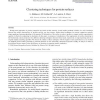Free Online Productivity Tools
i2Speak
i2Symbol
i2OCR
iTex2Img
iWeb2Print
iWeb2Shot
i2Type
iPdf2Split
iPdf2Merge
i2Bopomofo
i2Arabic
i2Style
i2Image
i2PDF
iLatex2Rtf
Sci2ools
PR
2006
2006
Clustering techniques for protein surfaces
Though most approaches to protein comparison are based on their structure, several studies produced evidence of a strict correlation between the surface characteristics of proteins and the way they interact. Surface-based techniques for protein comparison typically require applying clustering algorithms to the punctual 3D description of the surface in order to produce a compact surface representation, capable of effectively condensing its description. In this paper, we propose a formalization of the requirements for surface clustering in the biochemical context and present two different clustering techniques that meet them, based, respectively, on region-growing and on an original template matching algorithm. We discuss the validity of these techniques with the support of tests performed on a set of about one hundred protein models generated by punctual mutations of four structurally characterized proteins. Finally, an analysis is made of how different factors impact on the effectiven...
| Added | 14 Dec 2010 |
| Updated | 14 Dec 2010 |
| Type | Journal |
| Year | 2006 |
| Where | PR |
| Authors | Lorenzo Baldacci, Matteo Golfarelli, Alessandra Lumini, Stefano Rizzi |
Comments (0)

